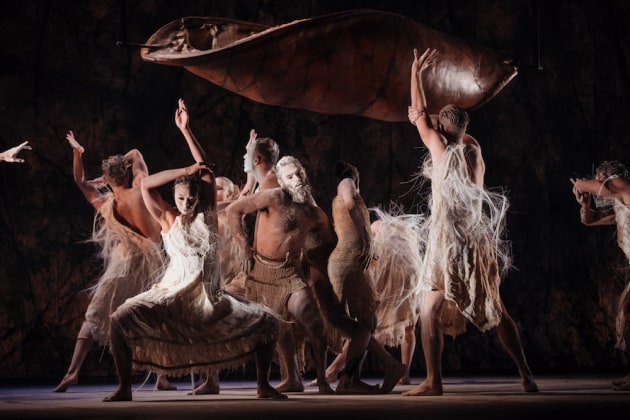Bangarra Dance Theatre, Dark Emu
Drama Theatre, Sydney Opera House, June 14
Bangarra Dance Theatre’s new production Dark Emu is a bold and thought-provoking work based on the ideas explored by Bruce Pascoe in his book of the same name. Published in 2014 and the winner of the 2016 NSW Premier’s Literary Awards, Pascoe’s book has garnered attention well beyond literary circles. Key concepts are that the hunter-gatherer tag applied to pre-colonial Indigenous people was not just incorrect, but wilfully misleading; that the evidence for this lies in early written accounts by a range of colonial explorers; and that the colonisation of Australia had devastating and far-reaching environmental impacts, overturning the balance of custodianship, respect and care for the land that had existed for thousands of years in Aboriginal and Torres Strait Islander society. So how, you might wonder, are such theoretical concepts translated into and communicated through the visual aesthetic of dance? As it turns out – surprisingly well, for the most part.
Approximately the first half of this 70-minute work is a series of scenes in which the dancer’s bodies are abstracted by costumes and choreography that depict them as native grass seeds, embers of fire, bogong moths or a type of native fly threatened by other dancers portraying the introduced blowfly. Jacob Nash’s set design is crucial in pulling off these scenes as the large scale of a carefully placed banksia cone or seed pod brings the dancers down to a much smaller scale than the human form generally implies. The latter half of Dark Emu I found a little more difficult to follow as it was not always clear whether the dancers were portraying elements of nature or their ancestors – and to what purpose. But importantly, the production remained aesthetically pleasing and interesting to watch.

Choreographic credits are shared by Artistic Director Stephen Page, current dancer Daniel Riley and former dancer Yolande Brown (with the dancers of Bangarra Dance Theatre). Dark Emu is primarily lyrical in quality, with circular waves of movement played out across different parts of the dancers’ bodies and echoing out into the broader patterns of the ensemble as they move across the stage. This is, essentially, an ensemble work, and there are few moments in which soloists are featured, making it difficult to single out any dancers for particular mention.
Costume designer Jennifer Irwin has created some outstanding costumes here; highlights for me included the textural, dry wisps of the "Kangaroo Grass" costumes and the colour variations of the skirts worn by dancers in the "Forged by Fire" section. Anyone who has sat around a campfire at night would recognise the choreographic differentiation between the lively red embers, and the smouldering, increasingly static qualities of the darker coals. Composer Steve Francis has incorporated sounds from nature that act as cues to help the audience locate themselves in the more abstracted scenes, while spoken excerpts from Bruce Pascoe’s book are laid over the music at times.
Dark Emu is touring Australia following its Sydney season and I recommend seeing it – but urge those attending to take the time to read the written programme (if not the book) beforehand in order to get the most out of this production.
- GERALDINE HIGGINSON
Dark Emu is touring nationally between June and September.
Pictured top: Beau Dean Riley Smith and Bangarra ensemble in Dark Emu. Photo: Daniel Boud.



